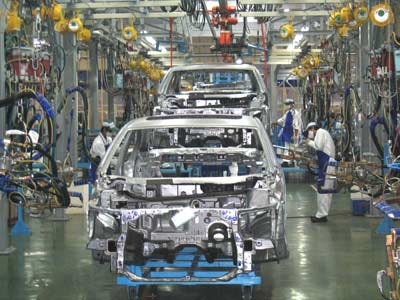Approving the Strategy for the Development of Vietnam's Automobile Industry
The strategy for developing the Vietnamese automobile industry to 2025, with a vision to 2035, sets a target that by 2035, the number of domestically produced and assembled vehicles will account for about 78% of domestic demand, while the total number of exported vehicles will reach about 90,000 units...
 |
| Illustration photo |
Develop vehicle lines suitable for traffic infrastructure
The Prime Minister has just approved the Strategy for developing Vietnam's automobile industry to 2025, with a vision to 2035.
According to the Strategy, priority will be given to product groups including: trucks and passenger cars with 10 seats or more; passenger cars with up to 9 seats; specialized vehicles and supporting industries. Specifically, for trucks and passenger cars with 10 seats or more, attention will be paid to developing multi-purpose small trucks serving agricultural and rural production and medium and short-range passenger cars running between provinces, districts, inner cities... suitable for terrain conditions, domestic traffic infrastructure with reasonable prices, safety and convenience.
For passenger vehicles with up to 9 seats, the focus will be on small personal vehicles that consume little energy, suitable for traffic infrastructure and people's income.
For specialized vehicles, select the production and assembly of some types of vehicles in high demand (concrete trucks, tank trucks, vehicles serving security, national defense, etc.); encourage the production of small multi-functional agricultural vehicles (combining cargo transport with one or more functions such as tilling land, pumping water, generating electricity, spraying pesticides, etc.) to meet the needs of people in rural and mountainous areas.
Regarding supporting industries, we will approach and apply technology to manufacture important parts and components such as transmissions, gearboxes, engines, car bodies, etc. for several vehicle models; strengthen cooperation with major automakers to select types of spare parts and components that Vietnam can produce to take on the role of a link in the global production and supply chain, on that basis, invest in advanced technology and produce for export.
Export about 90,000 units by 2035
The overall objective of the Strategy is to build the Vietnamese automobile industry into an important industry, meeting domestic market demand for vehicles with competitive advantages, participating in exports, creating momentum to promote the development of other industries and enhancing competitiveness to become a supplier of components and spare parts in the world automobile industrial production chain.
The target is that by 2035, total vehicle production will reach about 1,531,400 units, of which: vehicles with up to 9 seats will be about 852,600 units, from 10 seats or more will be about 84,400 units, trucks will be about 587,900 units, and specialized vehicles will be about 6,500 units. The proportion of domestically assembled vehicles accounts for about 78% of domestic demand.
Regarding the development of supporting industries, by 2020, the supporting industry for automobile production will be basically formed; striving to meet about 35% (in value) of the demand for components and spare parts for domestic automobile assembly production. In the period of 2026 - 2035, it will meet over 65% of the demand for components and spare parts for domestic automobile assembly production.
By 2035, the strategy strives to have total vehicle exports reach about 90,000 units.
Forming a number of automotive industry centers/clusters
To achieve the above goals, the Strategy has given specific directions such as identifying and establishing strategic partners, encouraging investment in projects large enough to create a market for supporting industries; encouraging the production of environmentally friendly vehicles (fuel-efficient vehicles, hybrid vehicles, biofuel vehicles, electric vehicles, etc.).
At the same time, form a number of concentrated automobile industrial centers/clusters on the basis of organizing and rearranging production; promote cooperation and association between automobile manufacturing and assembling enterprises, supporting industry enterprises, research and development establishments and training establishments of all economic sectors to improve investment efficiency and enhance specialization capacity...
According to chinhphu.vn






